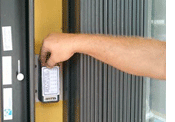 Access
Control Systems Access
Control Systems
Access control
is the ability to permit or deny the use of a particular
resource by a particular entity. Access control
mechanisms can be used in managing physical resources
(such as a movie theater, to which only ticket holders
should be admitted), logical resources (a bank account,
with a limited number of people authorized to make a
withdrawal), or digital resources (for example, a
private text document on a computer, which only certain
users should be able to read).
Item control or electronic key management is an area
within (and possibly integrated with) an access
control system which concerns the managing of
possession and location of small assets or physical
(mechanical) keys.
Physical access by a person may be allowed depending on
payment, authorization, etc. Also there may be one-way
traffic of people. These can be enforced by personnel
such as a border guard, a doorman, a ticket checker,
etc., or with a device such as a turnstile. There may be
fences to avoid circumventing this access control. An
alternative of access control in the strict sense
(physically controlling access itself) is a system of
checking authorized presence, see e.g. Ticket controller
(transportation). A variant is exit control, e.g. of a
shop (checkout) or a country.
In physical security, the term access control refers to
the practice of restricting entrance to a property, a
building, or a room to authorized persons. Physical
access control can be achieved by a human (a guard,
bouncer, or receptionist), through mechanical means such
as locks and keys, or through technological means such
as
access control systems like the Access control
vestibule. Within these environments, physical key
management may also be employed as a means of further
managing and monitoring access to mechanically keyed
areas or access to certain small assets.
Physical access control is a matter of who, where, and
when. An access control system determines who is
allowed to enter or exit, where they are allowed to exit
or enter, and when they are allowed to enter or exit.
Historically this was partially accomplished through
keys and locks. When a door is locked only someone with
a key can enter through the door depending on how the
lock is configured. Mechanical locks and keys do not
allow restriction of the key holder to specific times or
dates. Mechanical locks and keys do not provide records
of the key used on any specific door and the keys can be
easily copied or transferred to an unauthorized person.
When a mechanical key is lost or the key holder is no
longer authorized to use the protected area, the locks
must re-keyed.
Electronic
access control uses computers to solve the
limitations of mechanical locks and keys. A wide range
of credentials can be used to replace mechanical keys.
The electronic access control system grants access based
on the credential presented. When access is granted, the
door is unlocked for a predetermined time and the
transaction is recorded. When access is refused, the
door remains locked and the attempted access is
recorded. The system will also monitor the door and
alarm if the door is forced open or held open too long
after being unlocked.
|

